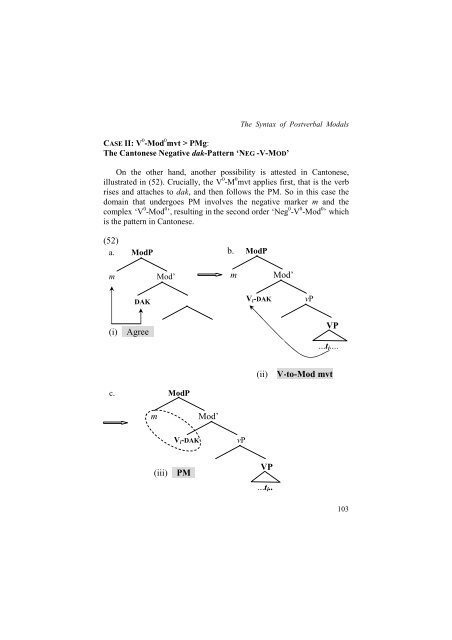investigating the syntax of postverbal modals in hakka
investigating the syntax of postverbal modals in hakka
investigating the syntax of postverbal modals in hakka
Create successful ePaper yourself
Turn your PDF publications into a flip-book with our unique Google optimized e-Paper software.
CASE II: V 0 -Mod 0 mvt > PMg:<br />
The Cantonese Negative dak-Pattern ‘NEG -V-MOD’<br />
The Syntax <strong>of</strong> Postverbal Modals<br />
On <strong>the</strong> o<strong>the</strong>r hand, ano<strong>the</strong>r possibility is attested <strong>in</strong> Cantonese,<br />
illustrated <strong>in</strong> (52). Crucially, <strong>the</strong> V 0 -M 0 mvt applies first, that is <strong>the</strong> verb<br />
rises and attaches to dak, and <strong>the</strong>n follows <strong>the</strong> PM. So <strong>in</strong> this case <strong>the</strong><br />
doma<strong>in</strong> that undergoes PM <strong>in</strong>volves <strong>the</strong> negative marker m and <strong>the</strong><br />
complex ‘V 0 -Mod 0 ’, result<strong>in</strong>g <strong>in</strong> <strong>the</strong> second order ‘Neg 0 -V 0 -Mod 0 ’ which<br />
is <strong>the</strong> pattern <strong>in</strong> Cantonese.<br />
(52)<br />
a. ModP b. ModP<br />
m Mod’<br />
DAK<br />
vP<br />
(i) Agree<br />
VP<br />
c. ModP<br />
m Mod’<br />
(iii) PM<br />
Vi-DAK vP<br />
m Mod’<br />
Vi-DAK vP<br />
(ii) V-to-Mod mvt<br />
VP<br />
...ti..<br />
VP<br />
...ti....<br />
103


